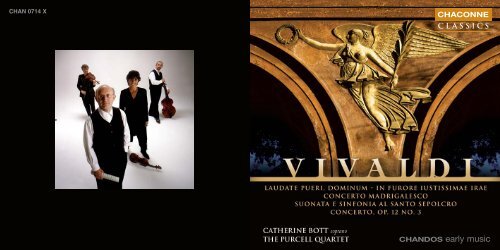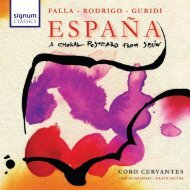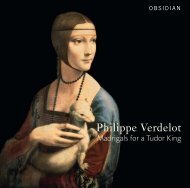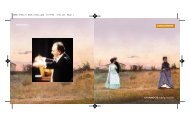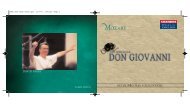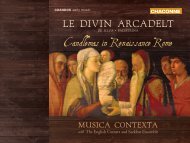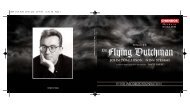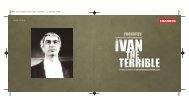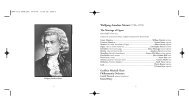You also want an ePaper? Increase the reach of your titles
YUMPU automatically turns print PDFs into web optimized ePapers that Google loves.
CHAN 0714 X Front.qxd 15/9/06 5:28 pm Page 1<br />
CHAN 0714 X<br />
CHACONNE<br />
CLASSICS<br />
<strong>CHANDOS</strong> <strong>early</strong> <strong>music</strong>
CHAN 0714 BOOK.qxd 15/9/06 5:33 pm Page 2<br />
Antonio Vivaldi (1678–1741)<br />
Lebrecht Music & Arts<br />
1<br />
3<br />
4<br />
5<br />
2<br />
Suonata a quattro al Santo Sepolcro, RV 130 3:34<br />
in E flat major • in Es-Dur • en mi bémol majeur<br />
I Largo molto – 1:44<br />
II Allegro ma poco 1:50<br />
In furore iustissimae irae, RV 626* 14:01<br />
Aria. In furore iustissimae irae 4:38<br />
Recitative. Miserationum Pater piissime –<br />
Aria. Tunc meus fletus 7:47<br />
Alleluia 1:36<br />
6<br />
7<br />
8<br />
Concerto a quattro, Op. 12 No. 3, RV 124 5:59<br />
in D major • in D-Dur • en ré majeur<br />
I Allegro 2:23<br />
II Grave – 1:50<br />
III Allegro 1:46<br />
Antonio Vivaldi, caricature by<br />
Pier Leone Ghezzi, c. 1723<br />
9<br />
10<br />
11<br />
12<br />
Concerto a quattro, RV 129 ‘Madrigalesco’ 4:14<br />
in D minor • in d-Moll • en ré mineur<br />
I Adagio – 0:55<br />
II Allegro – 1:35<br />
III Adagio – 0:48<br />
IV [Allegro molto moderato] 0:56<br />
3
CHAN 0714 BOOK.qxd 15/9/06 5:33 pm Page 4<br />
13<br />
14<br />
15<br />
16<br />
18<br />
19<br />
20<br />
21<br />
22<br />
23<br />
17<br />
Laudate pueri, Dominum, RV 601* † 24:32<br />
I Laudate pueri, Dominum 3:21<br />
II Sit nomen Domini benedictum 2:14<br />
III A solis ortu usque ad occasum 4:42<br />
IV Excelsus super omnes gentes Dominus 3:07<br />
V Suscitans a terra inopem 2:17<br />
VI Ut collocet eum cum principibus populi sui 1:58<br />
VII Gloria Patri et Filio et Spiritui sancto 3:49<br />
VIII Gloria Patri et Filio et Spiritui sancto 0:59<br />
IX Amen 1:56<br />
Sinfonia al Santo Sepolcro, RV 169 3:15<br />
in B minor • in h-Moll • en si mineur<br />
I Adagio molto – 1:41<br />
II Allegro ma poco 1:34<br />
TT 56:11<br />
Catherine Bott soprano*<br />
The Purcell Quartet<br />
Catherine Mackintosh • Catherine Weiss violins<br />
Richard Boothby cello<br />
Robert Woolley organ<br />
with<br />
Stephen Preston flute †<br />
Jane Rogers viola<br />
Cecelia Bruggemeyer double-bass<br />
flute Stephen Preston Rod Cameron, after Bressan<br />
violin Catherine Mackintosh Antonio Mariani, Pesaro 1674<br />
Catherine Weiss Tomaso Eberle, Naples 1770<br />
viola Jane Rogers Rex H. England, Paulersbury 1994, after Gaspar de Salo<br />
cello Richard Boothby James Mackay, 1995, after Andrea Amati, 1565<br />
double-bass Cecelia Bruggemeyer Roger Dawson, 1981, after Gaspar de Salo<br />
organ Robert Woolley single-manual, 3-stop continuo organ by William Drake, 1983<br />
Organ provided, tuned and maintained by Nigel Gardner<br />
Temperament: Sixth comma meantone<br />
Pitch: A = 440<br />
4<br />
5
CHAN 0714 BOOK.qxd 15/9/06 5:33 pm Page 6<br />
Vivaldi: Laudate pueri, Dominum and other works<br />
It is sometimes not appreciated, even today,<br />
how much of Vivaldi’s vast output qualifies<br />
as ‘church’ <strong>music</strong>. The compositions Vivaldi<br />
wrote for the Pio Ospedale della Pietà, the<br />
Venetian institution for foundlings with<br />
which he was associated for most of his<br />
working life, were n<strong>early</strong> all performed in its<br />
chapel in the context of religious services.<br />
Such works included not only settings of<br />
liturgical and non-liturgical Latin texts (the<br />
first category includes the Ordinary of the<br />
Mass, psalms, hymns and the Magnificat; the<br />
second, motets and oratorios) but also purely<br />
instrumental pieces – sinfonias, concertos<br />
and sonatas – which opened or concluded<br />
services and could even function as (so to<br />
speak) wordless motets during them. In fact,<br />
only his operas and cantatas can be excluded<br />
altogether from the sacred sphere.<br />
All the works in this recording belong to<br />
Vivaldi’s fullest maturity, which began with<br />
the composer’s return to Venice in 1720 after<br />
almost three years in Mantua.<br />
In furore iustissimae irae, RV 626 is a<br />
fine example of a solo motet for voice, strings<br />
and continuo. Vivaldi wrote it around<br />
1723–24 for Rome during one of his carnival<br />
sojourns there. This means that the original<br />
singer was almost certainly a castrato soprano.<br />
In this case, ‘authenticity’ is naturally<br />
impossible to achieve today, but it is important<br />
to be aware that Vivaldi and his Italian<br />
contemporaries conceived solo vocal parts less<br />
in terms of generic types (soprano/alto,<br />
male/female, dramatic/coloratura etc.) than<br />
according to the vocal qualities of the<br />
individual singers for whom they were first<br />
destined. In other words, who should sing a<br />
given part was, and is, largely a pragmatic<br />
matter. The present motet, on the theme of<br />
forgiveness for sins, is apt for all seasons. It is<br />
equally suited to performance at Mass and<br />
Vespers, and will have been introduced at one<br />
of the many points in either service (an<br />
example is after the Credo in the Mass) where<br />
the insertion of motets was traditionally<br />
tolerated by the Church. Its structure is<br />
conventional: two arias, respectively dramatic<br />
and contemplative, frame a short recitative, and<br />
the work is crowned by an exuberant ‘Alleluia’.<br />
It is interesting how, purely for the sake of<br />
<strong>music</strong>al ‘rounding’, the final movement recalls<br />
the fiery temper of the opening aria, even<br />
though the mood of the words has meanwhile<br />
changed from desperation to exultation!<br />
The Laudate pueri, Dominum, RV 601 is<br />
the last of three settings of this Vesper psalm<br />
(one, RV 602, existing in several variants)<br />
that Vivaldi composed. It appears to have<br />
been written for one of the singers of the<br />
Saxon court at Dresden around 1730 and<br />
contrasts with the earlier settings by being<br />
notably operatic in style (the D above the<br />
treble clef that appears near the end of the<br />
final ‘Amen’ is the highest note encountered<br />
in a vocal part anywhere in Vivaldi’s sacred<br />
<strong>music</strong>). The verses of the psalm are set singly<br />
or in pairs as separate movements, strongly<br />
contrasted among themselves in style,<br />
scoring, mood and key. The ‘Gloria Patri’<br />
uses the transverse flute (then still a novelty<br />
to most Italian composers) very hauntingly as<br />
an obbligato instrument. The most inventive<br />
movement is, however, the one immediately<br />
preceding it, ‘Ut collocet eum’, in which the<br />
second violins play, machine-like, an almost<br />
continuous series of even crotchets on a<br />
monotone that grate attractively against the<br />
notes of the first violins.<br />
The Concerto ‘Madrigalesco’, RV 129<br />
belongs to Vivaldi’s large number of ‘novelty’<br />
concertos. ‘Madrigalesque’ here means ‘in the<br />
style of vocal polyphony’. In fact, all the<br />
movements, except possibly the third, are<br />
closely based on sections from Vivaldi’s<br />
sacred vocal compositions. The first and<br />
second movements refer to the Kyrie,<br />
RV 587 and the last movement to the<br />
Magnificat, RV 610. To complicate matters,<br />
it is uncertain whether the vocal prototypes<br />
are not, in their turn, based on <strong>music</strong> by<br />
another composer. It is becoming clear today<br />
how extensively Vivaldi tacitly ‘borrowed’<br />
from older masters when writing in the stile<br />
antico – the strict polyphonic style going<br />
back to the days of Palestrina – and one<br />
cannot exclude this possibility in the case of<br />
these movements. Like the present D major<br />
concerto, RV 124, the Concerto<br />
‘Madrigalesco’ is a concerto a quattro: a<br />
concerto for strings in four parts without a<br />
soloist. Vivaldi was very attached to this<br />
genre – ironically so, since the impact of his<br />
own solo concertos had earlier done much to<br />
marginalise it among other composers.<br />
The Sinfonia al Santo Sepolcro, RV 169<br />
and the Suonata a quattro al Santo<br />
Sepolcro, RV 130 are the only two works of<br />
their kind that Vivaldi composed. The ‘Holy<br />
Sepulchre’ in question was probably a<br />
monstrance containing the Host exhibited<br />
during the devotion of the Forty Hours,<br />
6<br />
7
CHAN 0714 BOOK.qxd 15/9/06 5:33 pm Page 8<br />
which in Venice and elsewhere took place<br />
annually at varying times during the year but<br />
especially in Holy Week. A Lenten<br />
connection is perhaps signalled by Vivaldi’s<br />
instruction to perform the work without<br />
organ or harpsichord accompaniment. Like<br />
many of the overtures to contemporary<br />
Viennese sepolcri (a type of passion oratorio)<br />
these compositions are in only two<br />
movements: an emotionally charged Adagio<br />
(or Largo) leading into a pensive fugal<br />
Allegro. Works such as these stand as a<br />
reproach to those who suppose that Vivaldi<br />
was uninterested in counterpoint and lived<br />
only for virtuosic display!<br />
In 1729 the Amsterdam publisher Michel-<br />
Charles le Cène brought out a set of flute<br />
concertos and two volumes of violin<br />
concertos, Opp. 10–12. These were the last<br />
compositions that Vivaldi himself committed<br />
to print (those appearing later were either<br />
forgeries or works issued by publishers quite<br />
independently of his wishes). As he confessed<br />
to an English visitor in 1733, Vivaldi found<br />
it more profitable, in his later years, to sell<br />
his instrumental works in manuscript form<br />
to his patrons and customers. The last opus,<br />
Op. 12, contains, as its third work, a<br />
Concerto a quattro, RV 124 – sadly, the<br />
only one of its type that Vivaldi ever released<br />
in published form. This is a magnificent<br />
specimen of the genre. After a dashing first<br />
movement that contains some remarkably<br />
bold harmonic abrasions, a poignantly<br />
eloquent Grave leads to an even tenser fugue<br />
uniting rigour and passion.<br />
© Michael Talbot<br />
The soprano Catherine Bott studied at the<br />
Guildhall School of Music and Drama. For<br />
two years she sang everything from Bach to<br />
Berio as a member of the Swingle Singers,<br />
before beginning her solo career. Recognised<br />
as a virtuoso of <strong>early</strong> <strong>music</strong>, she is also much<br />
in demand by contemporary composers and<br />
has premiered several new works. Her<br />
international career has recently included<br />
recitals in the Concertgebouw, Amsterdam<br />
and the Konzerthaus, Vienna. A busy<br />
recording artist, she has produced an<br />
extensive discography for Chandos, which<br />
includes works by Handel and Vivaldi with<br />
The Purcell Quartet, and Vaughan Williams’s<br />
Sinfonia Antartica and Nielsen’s Third<br />
Symphony under the late Bryden Thomson;<br />
she is also featured in the series of CDs<br />
containing all Walton’s film <strong>music</strong>, singing<br />
‘Under the Greenwood Tree’ from As You<br />
Like It. Catherine Bott presents a weekly<br />
programme about <strong>early</strong> <strong>music</strong> on BBC<br />
Radio 3.<br />
Founded in 1983, The Purcell Quartet has<br />
established itself as a leading performer of<br />
baroque <strong>music</strong>. The group has appeared all<br />
over the world, including North and South<br />
America and all the countries of Europe, and<br />
for over ten years has been a regular visitor to<br />
Japan, touring extensively with fully staged<br />
performances of Purcell’s Dido and Aeneas<br />
and Monteverdi’s L’incoronazione di Poppea<br />
and L’Orfeo. The Quartet has played at most<br />
of the major festivals in the United<br />
Kingdom, recorded extensively for the BBC,<br />
and toured with the Early Music Network.<br />
In 2000 it presented several programmes of<br />
Bach’s <strong>music</strong>, including the <strong>early</strong> cantatas at<br />
the Spitalfields Festival, Lutheran Masses in<br />
Budapest, harpsichord concertos in Salzburg<br />
and, on the anniversary of Bach’s death, a<br />
concert of funeral cantatas at the Wigmore<br />
Hall. The Purcell Quartet has recorded a<br />
huge range of <strong>music</strong> exclusively for Chandos,<br />
including works by Purcell, Corelli, Lawes,<br />
Bach, Handel, Vivaldi, Weckmann, Leclair,<br />
Schütz, Couperin and Biber, to outstanding<br />
critical and public acclaim.<br />
8<br />
9
CHAN 0714 BOOK.qxd 15/9/06 5:33 pm Page 10<br />
Vivaldi: Laudate pueri, Dominum und andere Werke<br />
Bis auf den heutigen Tag kommt es zu<br />
gelegentlichen Fehleinschätzungen darüber,<br />
wieviel von Vivaldis umfangreichem Schaffen<br />
die Bedingungen erfüllt, “Kirchenmusik”<br />
genannt zu werden. Die Kompositionen, die<br />
er für das Pio Ospedale della Pietà schrieb,<br />
jenes venezianische Findlingsheim, dem er<br />
beinahe sein ganzes Berufsleben lang<br />
verbunden war, wurden fast alle in der<br />
dortigen Kapelle im Rahmen von Andachten<br />
aufgeführt. Es handelt sich bei diesen Werken<br />
nicht nur um Vertonungen liturgischer und<br />
anderer lateinischer Texte (zur ersten Kategorie<br />
zählen das Messe-Ordinarium, Psalmen,<br />
Kirchenlieder und das Magnificat, zur zweiten<br />
Motetten und Oratorien), sondern auch um<br />
reine Instrumentalwerke, nämlich Sinfonien,<br />
Konzerte und Sonaten, die den Gottesdienst<br />
eröffneten oder beschlossen, manchmal sogar<br />
zwischendurch als (sozusagen) wortlose<br />
Motetten fungieren konnten. Mithin lassen<br />
sich nur Vivaldis Opern und Kantaten ganz<br />
aus dem sakralen Bereich ausklammern.<br />
Sämtliche Werke dieser Einspielung<br />
entstammen Vivaldis Hochblüte, die 1720<br />
begann, als der Komponist nach beinahe drei<br />
Jahren in Mantua nach Venedig<br />
zurückkehrte.<br />
In furore iustissimae irae RV 626 ist ein<br />
schönes Beispiel einer Solomotette für Gesang,<br />
Streicher und Continuo. Vivaldi schrieb sie<br />
um 1723/24 für Rom, während er sich dort<br />
wieder einmal zum Karneval aufhielt. Das<br />
bedeutet, daß sie ursprünglich von einem<br />
Kastratensopran gesungen worden sein muß.<br />
In so einem Fall ist “Authentizität” heutzutage<br />
natürlich nicht herzustellen, aber es kommt<br />
auch vor allem darauf an, sich vor Augen zu<br />
führen, daß Vivaldi und seine italienischen<br />
Zeitgenossen Sologesangspartien weniger<br />
nach Gattungsbegriffen (Sopran/Alt,<br />
männlich/weiblich, dramatisch/Koloratur<br />
usw.) gestaltet haben als nach den stimmlichen<br />
Eigenheiten des jeweiligen Sängers, für den sie<br />
vorgesehen waren. Mit anderen Worten: Wer<br />
eine bestimmte Partie singen soll, war und ist<br />
im wesentlichen eine pragmatische<br />
Entscheidung. Die vorliegende Motette, die<br />
von der Sündenvergebung handelt, ist für alle<br />
Gelegenheiten passend. Sie eignet sich gleich<br />
gut zur Aufführung während der Messe und<br />
der Vesper und wurde wahrscheinlich an einer<br />
der vielen Stellen eingefügt (in der Messe zum<br />
Beispiel nach dem Credo), an denen die<br />
kirchliche Tradition den Einschub von<br />
Motetten duldete. Ihr Aufbau ist<br />
konventionell: Zwei Arien, die eine<br />
dramatisch, die andere besinnlich, umrahmen<br />
ein kurzes Rezitativ, und das Werk wird von<br />
einem überschwenglichen “Alleluja” gekrönt.<br />
Interessant ist, wie der letzte Satz der<br />
musikalischen “Abrundung” zuliebe an die<br />
hitzig temperamentvolle erste Arie erinnert,<br />
auch wenn die Stimmung des Textes<br />
inzwischen von Verzweiflung in Frohlocken<br />
übergegangen ist!<br />
Das Laudate pueri, Dominum RV 601 ist<br />
die letzte von drei Vertonungen dieses<br />
Vesperpsalms (von einer, RV 602, sind<br />
mehrere Versionen erhalten), die Vivaldi<br />
komponiert hat. Allem Anschein nach wurde<br />
sie um 1730 für einen Sänger am sächsischen<br />
Hof zu Dresden verfaßt und unterscheidet<br />
sich von den vorangegangenen Vertonungen<br />
dadurch, daß sie vom Stil her deutlich<br />
opernhaft ist (das D über der Notenzeile mit<br />
G-Schlüssel, das gegen Ende des<br />
abschließenden “Amen” aufscheint, ist die<br />
höchste Note, die in den Gesangspartien der<br />
Sakralwerke Vivaldis überhaupt vorkommt).<br />
Die Strophen des Psalms sind einzeln oder in<br />
Paaren als getrennte Sätze vertont und durch<br />
starke Kontraste in Stil, Besetzung,<br />
Stimmung und Tonart voneinander<br />
abgesetzt. Das “Gloria Patri” setzt die<br />
Querflöte (damals noch eine Neuheit für die<br />
meisten italienischen Komponisten) überaus<br />
ergreifend als Obligatoinstrument ein. Der<br />
einfallsreichste Satz ist jedoch das<br />
unmittelbar vorausgehende “Ut collocet<br />
eum”; dort spielen die zweiten Geigen<br />
maschinengleich eine nahezu<br />
ununterbrochene Folge gleichmäßiger Viertel<br />
auf einem Ton, die sich angenehm an den<br />
Klängen der ersten Violinen reibt.<br />
Das Concerto “Madrigalesco” RV 129 ist<br />
eines von vielen “Novitätenkonzerten”<br />
Vivaldis. “Madrigalesk” bedeutet hier “im<br />
polyphonen Gesangsstil”. Tatsächlich lehnen<br />
sich alle Sätze, der dritte möglicherweise<br />
ausgenommen, eng an Abschnitte aus<br />
Vivaldis sakralen Gesangskompositionen an.<br />
Der erste und zweite Satz gehen auf das<br />
Kyrie RV 587 zurück, der letzte Satz auf das<br />
Magnificat RV 610. Zusätzlich kompliziert<br />
wird die Sache dadurch, daß man nicht weiß,<br />
ob diese Vokalmusikvorlagen nicht ihrerseits<br />
auf Stücken eines anderen Komponisten<br />
beruhen. Erst heute wird klar, in welchem<br />
Ausmaß Vivaldi sich stillschweigend bei<br />
älteren Meistern bedient hat, wenn er im stile<br />
antico komponierte, dem streng polyphonen<br />
10<br />
11
CHAN 0714 BOOK.qxd 15/9/06 5:33 pm Page 12<br />
Stil aus der Zeit Palestrinas, und diese<br />
Möglichkeit ist auch im Fall der Konzertsätze<br />
nicht auszuschließen. Wie das D-Dur-<br />
Konzert RV 124 ist das Concerto<br />
“Madrigalesco” ein concerto a quattro: ein<br />
Konzert für Streichinstrumente zu vier<br />
Stimmen ohne Solist. Vivaldi war diesem<br />
Genre sehr zugetan – eine Ironie, da der<br />
Erfolg seiner Solokonzerte zuvor viel dazu<br />
beigetragen hatte, es anderen Komponisten<br />
zu verleiden.<br />
Die Sinfonia al Santo Sepolcro RV 169<br />
und die Suonata a quattro al Santo<br />
Sepolcro RV 130 sind die einzigen zwei<br />
Werke ihrer Art, die Vivaldi komponiert<br />
hat. Mit dem “heiligen Grab” war<br />
vermutlich eine Monstranz mit der Hostie<br />
gemeint, die während der<br />
Vierzigstundenandacht gezeigt wurde; diese<br />
Andacht wurde in Venedig und anderswo<br />
alljährlich zu verschiedenen Zeiten des<br />
Jahres, aber vor allem in der Karwoche<br />
abgehalten. Einen Bezug zur Fastenzeit<br />
signalisiert möglicherweise Vivaldis<br />
Anweisung, das Werk ohne Orgel- oder<br />
Cembalobegleitung aufzuführen. Wie viele<br />
Ouvertüren zu den sepolcri (gemeint ist eine<br />
Art Osteroratorium), die um jene Zeit in<br />
Wien entstanden, haben auch diese Werke<br />
nur zwei Sätze: ein emotional aufgeladenes<br />
Adagio (oder Largo), das in ein besinnliches<br />
fugales Allegro übergeht. Werke wie diese<br />
strafen all jene Lügen, die Vivaldi<br />
unterstellen, er habe sich nicht für den<br />
Kontrapunkt interessiert und nur für den<br />
virtuosen Schein gelebt!<br />
Im Jahr 1729 brachte der Amsterdamer<br />
Verleger Michel-Charles le Cène als<br />
op. 10–12 eine Zusammenstellung von<br />
Flötenkonzerten und zwei Bände mit<br />
Violinkonzerten heraus. Dies waren die<br />
letzten Kompositionen, die Vivaldi selbst in<br />
Druck gegeben hat (jene, die später<br />
erschienen, waren entweder Fälschungen<br />
oder Werke, die ohne sein Zutun von<br />
Verlegern herausgegeben wurden). Wie er<br />
einem englischen Besucher 1733 gestand,<br />
fand Vivaldi es im späteren Leben<br />
einträglicher, seine Instrumentalwerke in<br />
Manuskriptform an Gönner und Kunden zu<br />
verkaufen. Sein abschließendes Opus 12<br />
enthält als drittes Werk ein Concerto a<br />
quattro RV 124 – leider das einzige seiner<br />
Art, das Vivaldi je zur Veröffentlichung<br />
freigegeben hat. Es ist ein prachtvolles<br />
Exemplar seiner Gattung. Im Anschluß an<br />
einen schwungvollen ersten Satz, in dem es<br />
zu einigen bemerkenswert kühnen<br />
harmonischen Kollisionen kommt, leitet ein<br />
rührend beredtes Grave in eine noch<br />
spannungsreichere Fuge über, die Stringenz<br />
und Leidenschaft vereint.<br />
© Michael Talbot<br />
Übersetzung: Anne Steeb/Bernd Müller<br />
Die Sopranistin Catherine Bott studierte an<br />
der Guildhall School of Music and Drama.<br />
Bevor sie eine solistische Laufbahn einschlug,<br />
sang sie als Mitglied der Swingle Singers zwei<br />
Jahre lang alles von Bach bis Berio. Sie ist<br />
nicht nur eine anerkannte Virtuosin der<br />
frühen Musik, sondern auch bei<br />
zeitgenössischen Komponisten sehr gefragt<br />
und hat die Premieren einer Reihe von neuen<br />
Stücken gesungen. Ihre internationale<br />
Karriere führte sie in jüngster Zeit mit<br />
Solorecitals ins Amsterdamer Concertgebouw<br />
und ins Wiener Konzerthaus. Ihre rege<br />
Aufnahmetätigkeit umfaßt eine ausgedehnte<br />
Diskographie bei Chandos, die unter<br />
anderem Werke von Händel und Vivaldi mit<br />
dem Purcell Quartet und Vaughan Williams’<br />
Sinfonia Antartica sowie Nielsens Dritte<br />
Sinfonie unter dem verstorbenen Bryden<br />
Thomson enthält; Bott ist auch in einer CD-<br />
Reihe mit der Gesamteinspielung der<br />
Filmmusik von Sir William Walton zu hören,<br />
wo sie “Under the Greenwood Tree” aus As<br />
You Like It singt. Für BBC Radio 3<br />
moderiert Catherine Bott ein wöchentliches<br />
Programm über Alte Musik.<br />
Das 1983 gegründete Purcell Quartet gilt als<br />
eines der führenden Barockensembles unserer<br />
Zeit. Weltweite Gastspielreisen haben es nach<br />
Nord- und Südamerika, durch ganz Europa<br />
und seit mehr als zehn Jahren regelmäßig nach<br />
Japan geführt, u.a. mit szenischen<br />
Aufführungen von Purcells Dido and Aeneas<br />
und Monteverdis L’incoronazione di Poppea<br />
und L’Orfeo. Das Ensemble ist bei den meisten<br />
namhaften Festivals in Großbritannien<br />
aufgetreten, hat zahlreiche Aufnahmen für die<br />
BBC eingespielt und ist mit dem Early Music<br />
Network auf Tournee gegangen. Im Jahr 2000<br />
machte es mit verschiedenen Bach-<br />
Programmen von sich reden, darunter die<br />
frühen Kantaten beim Spitalfields Festival, die<br />
Vier kleine Messen in Budapest, Cembalokonzerte<br />
in Salzburg und zum Todestag Bachs<br />
ein Konzert mit Trauerkantaten in der<br />
Londoner Wigmore Hall. Das Purcell Quartet<br />
verfügt über eine umfangreiche Exklusiv-<br />
Diskographie bei Chandos, mit Werken von<br />
Purcell, Corelli, Lawes, Bach, Händel, Vivaldi,<br />
Weckmann, Leclair, Schütz, Couperin und<br />
Biber, die von der Kritik und von der<br />
Öffentlichkeit mit großer Begeisterung<br />
aufgenommen worden sind.<br />
12<br />
13
CHAN 0714 BOOK.qxd 15/9/06 5:33 pm Page 14<br />
Vivaldi: Laudate pueri, Dominum et autres œuvres<br />
De nos jours encore, il est parfois difficile<br />
d’apprécier quelle part de la vaste production<br />
de Vivaldi peut être qualifiée de musique<br />
“sacrée”. Les œuvres composées pour le Pio<br />
Ospedale della Pietà, l’hospice vénitien pour<br />
enfants abandonnés auquel il fut attaché<br />
pendant la plus grande partie de sa vie active,<br />
furent presque toutes exécutées dans la<br />
chapelle de cette institution lors d’offices<br />
religieux. Vivaldi ne se contentait pas de<br />
mettre en musique des textes latins<br />
liturgiques ou non (la première catégorie<br />
incluant l’ordinaire de la messe, des psaumes,<br />
des hymnes et le Magnificat; la seconde, des<br />
motets et des oratorios). Parmi ses<br />
compositions figuraient également des pièces<br />
essentiellement instrumentales – sinfonias,<br />
concertos et sonates – exécutées en début ou<br />
en fin d’office et pouvant même jouer, en<br />
cours d’office, le rôle de motets “sans paroles”<br />
(en quelque sorte). En fait, seuls ses opéras et<br />
ses cantates peuvent réellement être exclus de<br />
la sphère sacrée.<br />
Toutes les œuvres qui font partie du<br />
présent enregistrement datent de la période<br />
de pleine maturité de Vivaldi qui débute lors<br />
14<br />
de son retour à Venise en 1720, au terme de<br />
près de trois années passées à Mantoue.<br />
In furore iustissimae irae, RV 626 est un<br />
bel exemple de motet solo pour voix, cordes<br />
et continuo. Vivaldi l’écrivit vers 1723–1724<br />
pour la ville de Rome, lors d’un des séjours<br />
qu’il avait coutume d’y faire à l’occasion du<br />
carnaval. Il est presque certain, donc, que le<br />
chanteur originel était un castrat soprano. Et<br />
en ce cas, l’“authenticité” est bien sûr<br />
impossible à restituer de nos jours. Toutefois,<br />
il est essentiel de savoir que Vivaldi et ses<br />
contemporains italiens concevaient les solos<br />
vocaux moins en termes de types génériques<br />
(soprano/alto, voix d’homme/de femme,<br />
dramatique/coloratur etc.) qu’en fonction<br />
des qualités vocales de chacun des chanteurs<br />
auxquels ils étaient destinés. En d’autres<br />
termes, le choix de l’interprète relevait, et<br />
relève toujours, dans une large mesure, de<br />
considérations pragmatiques. Le présent<br />
motet qui a pour thème le pardon pouvait<br />
être exécuté en toute saison, lors de la messe<br />
ou lors des vêpres, à l’un des nombreux<br />
moments de l’un ou l’autre de ces offices (par<br />
exemple après le Credo de la messe) où<br />
l’insertion de motets était traditionnellement<br />
tolérée par l’Église. Sa structure est<br />
conventionnelle: deux arias, l’une<br />
dramatique, l’autre méditative, encadrent un<br />
bref récitatif, et un “Alléluia” exubérant<br />
couronne l’œuvre. Il est intéressant de noter<br />
combien, dans le seul but de créer une<br />
“boucle” dans l’œuvre, le mouvement final<br />
rappelle la fougue de l’aria introductive,<br />
malgré le changement de coloration: le<br />
désespoir s’étant mué en exultation!<br />
Le Laudate pueri, Dominum, RV 601 est<br />
la dernière des trois adaptations faites par<br />
Vivaldi de ce psaume extrait des vêpres (il<br />
existe de l’une d’elles – RV 602 – diverses<br />
variantes). Elle semble avoir été écrite pour<br />
un des chanteurs de la cour saxonne à Dresde<br />
aux environs de 1730. Cette pièce contraste<br />
par son style rappelant l’opéra avec les<br />
adaptations antérieures (en clé de sol, le ré<br />
au-dessus de la portée à la fin du dernier<br />
“Amen” est, dans la musique sacrée de<br />
Vivaldi, la note la plus haute apparaissant<br />
dans une partie vocale). Les versets du<br />
psaume sont mis en musique seuls ou par<br />
paires sous forme de mouvements séparés,<br />
fortement contrastés quant au style, à<br />
l’orchestration, à la coloration ou à la<br />
tonalité. Le “Gloria Patri” fait appel à la flûte<br />
traversière (une nouveauté encore pour la<br />
15<br />
plupart des compositeurs italiens) d’une<br />
manière très obsédante, comme s’il s’agissait<br />
d’un instrument obbligato. Le mouvement le<br />
plus inventif est toutefois celui qui précède,<br />
“Ut collocet eum”, dans lequel les seconds<br />
violons jouent, tels une mécanique, une série<br />
presque continue de noires, monocordes, qui<br />
tranchent de manière plaisante sur les notes<br />
des premiers violons.<br />
Le Concerto “Madrigalesco”, RV 129 fait<br />
partie des nombreux concertos “nouveaux”<br />
de Vivaldi. “Madrigalesque”, ici, signifie<br />
“dans le style de la polyphonie vocale”. En<br />
fait, tous les mouvements, sauf peut-être le<br />
troisième, s’inspirent directement de pièces<br />
vocales faisant partie de la musique sacrée de<br />
Vivaldi. Les premier et deuxième<br />
mouvements se réfèrent au Kyrie, RV 587 et<br />
le dernier, au Magnificat, RV 610. Pour<br />
compliquer la chose, rien ne permet<br />
d’affirmer que ces prototypes vocaux, à leur<br />
tour, ne soient fondés sur des œuvres d’un<br />
autre compositeur. Il apparaît aujourd’hui à<br />
quel point Vivaldi “empruntait” tacitement<br />
les idées de maîtres plus anciens lorsqu’il<br />
écrivait dans le stile antico – le style<br />
polyphonique strict qui datait de l’époque de<br />
Palestrina – et cette éventualité ne peut en<br />
l’occurrence être exclue. Comme le Concerto<br />
en ré majeur, RV 124, le Concerto
CHAN 0714 BOOK.qxd 15/9/06 5:33 pm Page 16<br />
“Madrigalesco” est un concerto a quattro: un<br />
concerto pour cordes en quatre parties, sans<br />
soliste. Vivaldi avait une prédilection pour ce<br />
genre – une ironie du sort, si l’on sait que<br />
l’impact de ses propres concertos solos avait<br />
largement contribué à ce que d’autres<br />
compositeurs considèrent ce genre-ci comme<br />
marginal.<br />
La Sinfonia al Santo Sepolcro, RV 169 et<br />
la Suonata a quattro al Santo Sepolcro,<br />
RV 130 sont les seules œuvres de ce type<br />
composées par Vivaldi. Le “saint sépulcre” en<br />
question était sans doute un ostensoir exposé<br />
pendant la prière des quarante heures qui<br />
avait lieu annuellement à Venise et ailleurs, à<br />
divers moments de l’année, mais surtout<br />
pendant la semaine sainte. Vivaldi<br />
recommande d’exécuter l’œuvre sans<br />
accompagnement d’orgue ou de clavecin, ce<br />
qui pourrait être l’indice d’une connexion<br />
avec le Carême. Comme nombreuses autres<br />
ouvertures de sepolcri viennois contemporains<br />
(un genre d’oratorio de la Passion), ces pièces<br />
ne comprennent que deux mouvements: un<br />
Adagio (ou Largo) plein d’émotion menant à<br />
un Allegro fugué méditatif. Les œuvres de ce<br />
type démentent les affirmations de certains<br />
selon lesquels Vivaldi n’était pas intéressé par<br />
le contrepoint et avait pour seul souci de<br />
faire montre de virtuosité!<br />
En 1729, l’éditeur amstellodamois Michel-<br />
Charles le Cène publie un recueil de<br />
concertos pour flûte et deux volumes de<br />
concertos pour violon, op. 10–12. Ce sont<br />
les dernières compositions que Vivaldi se<br />
charge, lui-même, de faire imprimer (celles<br />
éditées plus tard sont soit des contrefaçons,<br />
soit des œuvres publiées sans qu’il en ait<br />
exprimé le souhait). Comme il le laisse<br />
entendre à un visiteur anglais en 1733,<br />
Vivaldi trouve plus intéressant, à la fin de sa<br />
vie, de vendre ses œuvres instrumentales sous<br />
forme de manuscrit à ses mécènes ou clients.<br />
La troisième œuvre de l’op. 12, le dernier, est<br />
un Concerto a quattro, RV 124 –<br />
malheureusement le seul de ce type que<br />
Vivaldi fit éditer. C’est un magnifique<br />
spécimen du genre. Après un premier<br />
mouvement impétueux, émaillé de quelques<br />
hardiesses harmoniques remarquables, un<br />
Grave d’une éloquence poignante mène à une<br />
fugue imprégnée de plus d’émotion encore,<br />
alliant rigueur et passion.<br />
© Michael Talbot<br />
Traduction: Marie-Françoise de Meeûs<br />
La soprano Catherine Bott a fait ses études à<br />
la Guildhall School of Music and Drama de<br />
Londres. Avant de commencer sa carrière de<br />
soliste, elle fut membre des Swingle Singers,<br />
chantant des œuvres allant de Bach à Berio.<br />
Reconnue comme une virtuose dans le<br />
domaine de la musique ancienne, elle est<br />
également très demandée par des<br />
compositeurs contemporains, et a créé<br />
plusieurs œuvres nouvelles. Sa carrière l’a<br />
conduite récemment à se produire en récital<br />
au Concertgebouw d’Amsterdam et au<br />
Konzerthaus de Vienne. Catherine Bott<br />
enregistre beaucoup, et a construit une vaste<br />
discographie pour Chandos, incluant des<br />
œuvres de Haendel et Vivaldi avec le Purcell<br />
Quartet, la Sinfonia Antartica de Vaughan<br />
Williams et la Troisième Symphonie de<br />
Nielsen sous la direction du regretté Bryden<br />
Thomson. Elle figure également dans une<br />
série de disques consacrés aux partitions<br />
complètes de musique de film de Walton,<br />
interprétant “Under the Greenwood Tree”<br />
extrait de As You Like It. Catherine Bott<br />
présente sur les ondes de la BBC Radio 3<br />
une émission hebdomadaire consacrée à la<br />
musique ancienne.<br />
Fondé en 1983, le Purcell Quartet s’est<br />
imposé comme un ensemble de musique<br />
baroque des plus remarquables. Il s’est<br />
produit dans le monde entier, notamment en<br />
Amérique du Nord et du Sud, dans tous les<br />
pays d’Europe, et régulièrement au Japon<br />
pendant plus de dix ans où il a effectué de<br />
nombreuses tournées interprétant des opéras<br />
entièrement mis en scène tels que Dido and<br />
Aeneas de Purcell et L’incoronazione di Poppea<br />
et L’Orfeo de Monteverdi. Le Purcell Quartet<br />
a joué dans la plupart des grands festivals de<br />
Grande-Bretagne. Il a réalisé de nombreux<br />
enregistrements pour la BBC, et fait des<br />
tournées avec l’Early Music Network. En<br />
2000, il a présenté plusieurs programmes<br />
consacrés à la musique de J.S. Bach: cantates<br />
de jeunesse au Spitalfields Festival, messes<br />
luthériennes à Budapest, concertos pour<br />
clavecin à Salzbourg et, le jour anniversaire<br />
de la mort de Bach, un concert de cantates<br />
funèbres au Wigmore Hall de Londres. Le<br />
Purcell Quartet a enregistré un très vaste<br />
répertoire en exclusivité pour Chandos,<br />
notamment des œuvres de Purcell, Corelli,<br />
Lawes, Bach, Haendel, Vivaldi, Weckmann,<br />
Leclair, Schütz, Couperin et Biber. Ces<br />
enregistrements lui ont valu les louanges<br />
enthousiastes de la critique et du public.<br />
16<br />
17
CHAN 0714 BOOK.qxd 15/9/06 5:33 pm Page 18<br />
Sous l’empire de ton courroux, ô combien<br />
juste<br />
Aria<br />
Sous l’empire de ton courroux, ô combien juste,<br />
Du haut des cieux, Seigneur, donne-moi la force.<br />
Car si tu peux châtier mon impiété,<br />
Celle-ci même révèle ta bonté.<br />
Récitatif<br />
Très saint Père de miséricorde,<br />
Épargne-moi lorsque je suis en pleurs,<br />
Impuissant pêcheur,<br />
Ô très doux Jésus.<br />
Aria<br />
Mon affliction dès lors<br />
Se changera en joie<br />
Tandis que, pour toi,<br />
Mon cœur s’attendrira.<br />
Aide-moi à pleurer,<br />
Mon doux Jésus,<br />
Des larmes<br />
Qui nourriront mon cœur.<br />
Alléluia<br />
Im Furor deines überaus gerechten<br />
Zorns<br />
Arie<br />
Im Furor deines überaus gerechten Zorns<br />
Machst du vom Himmel herab mich stark.<br />
Da du mich strafen kannst, so ich gesündigt,<br />
Ist mein Vergehn selbst Zeugnis deiner Güte.<br />
Rezitativ<br />
Heiligster Vater der Gnaden,<br />
Verschone mich, wenn ich beklage<br />
Einen machtlosen Sünder,<br />
O liebster Jesu Christ.<br />
Arie<br />
Dann wird mein Weinen<br />
Sich als freudig erweisen,<br />
Während nach dir<br />
Schmachtet mein Herz.<br />
Mache mich klagen,<br />
Mein lieber Jesu Christ,<br />
Dann wird mein Weinen<br />
Hegen mein Herz.<br />
Alleluja<br />
3<br />
In furore iustissimae irae<br />
Aria<br />
In furore iustissimae irae<br />
Tu divinitus facis potentem.<br />
Quando potes me reum punire<br />
Ipsum crimen te gerit clementem.<br />
Recitative<br />
Miserationum Pater piissime,<br />
Parce mihi dolenti<br />
Peccatori languenti,<br />
O Jesu, dulcissime.<br />
Aria<br />
Tunc meus fletus<br />
Evadet laetus<br />
Dum pro te meum<br />
Languescit cor.<br />
Fac me plorare,<br />
Mi Jesu care,<br />
Et fletus laetum<br />
Fovebit cor.<br />
Alleluia<br />
In the wrath of thy most righteous<br />
anger<br />
Aria<br />
In the wrath of thy most righteous anger<br />
You from heaven make me mighty.<br />
Since you can punish me when guilty<br />
My very crime shows you as kindly.<br />
Recitative<br />
Most holy Father of mercies,<br />
Spare me when I lament,<br />
A powerless sinner,<br />
O Jesus, most dear.<br />
Aria<br />
Then my weeping<br />
Will turn out joyful<br />
While for thee<br />
My heart grows faint.<br />
Make me lament,<br />
My Jesus dear,<br />
And my weeping<br />
Will nurture my heart.<br />
Alleluia<br />
4<br />
5<br />
Louez, serviteurs du Seigneur<br />
I<br />
Louez, serviteurs du Seigneur,<br />
Ô louez le nom du Seigneur,<br />
Lobet den Herren, alle seine Diener<br />
I<br />
Lobet den Herrn, alle seine Diener.<br />
Oh, lobet den Namen des Herrn.<br />
13<br />
Laudate pueri, Dominum<br />
I<br />
Laudate pueri, Dominium.<br />
Laudate nomen Domini.<br />
Praise the Lord, ye servants<br />
I<br />
Praise the Lord, ye servants.<br />
O praise the Name of the Lord.<br />
II<br />
Béni soit le nom du Seigneur, dès maintenant et à<br />
jamais.<br />
II<br />
Geheiligt sei der Name des Herrn, jetzt und in alle<br />
Ewigkeit.<br />
14<br />
II<br />
Sit nomen Domini benedictum, ex hoc nunc et<br />
usque in saeculum.<br />
II<br />
Blessed be the Name of the Lord from this time<br />
forth for evermore.<br />
18<br />
19
CHAN 0714 BOOK.qxd 15/9/06 5:33 pm Page 20<br />
III<br />
De l’aube au couchant, loué soit le nom du<br />
Seigneur.<br />
III<br />
Der Name des Herrn sei gelobt vom Morgen bis<br />
zum Abend.<br />
15<br />
III<br />
A solis ortu usque ad occasum, laudabile,<br />
nomen Domini.<br />
III<br />
The Lord’s Name be praised from the rising up of<br />
the sun unto the going down of the same.<br />
IV<br />
Le Seigneur règne sur toutes les nations et sa gloire,<br />
sur les cieux.<br />
Qui donc ressemble au Seigneur notre Dieu qui<br />
demeure dans les hauteurs et se fait humble pour<br />
veiller sur le ciel et la terre<br />
IV<br />
Der Herr regiert über alle Heiden und seine<br />
Herrlichkeit über alle Himmel.<br />
Wer mißt sich mit dem Herrn unserem Gott, der<br />
sich in seiner Hoheit nicht schämt, alle Dinge im<br />
Himmel und auf Erden zu sehen<br />
16<br />
IV<br />
Excelsus super omnes gentes Dominus, et super<br />
coelos gloria eius.<br />
Quis sicut Dominus Deus noster, qui in altis<br />
habitat et humilia respicit in coelo et in terra<br />
IV<br />
The Lord is high above all nations and his glory<br />
above the heavens.<br />
Who is like the Lord our God, that hath his<br />
dwelling so high and yet humbles himself to<br />
behold the things that are in heaven and earth<br />
V<br />
Qui relève le simple de la poussière et de la fange,<br />
l’indigent<br />
V<br />
Er hebt den Geringsten aus dem Staub und den<br />
Bettler aus dem Morast<br />
17<br />
V<br />
Suscitans a terra inopem, et de stercore erigens<br />
pauperem:<br />
V<br />
He taketh up the simple out of the dust and lifteth<br />
the poor out of the mire,<br />
VI<br />
Pour l’asseoir avec les princes, avec les princes de<br />
son peuple.<br />
Qui fait d’une femme stérile en sa maison, la mère<br />
heureuse de ses enfants.<br />
VI<br />
Und macht ihn den Prinzen gleich, ja, den Prinzen<br />
seines eigenen Volkes.<br />
Er macht die unfruchtbare Frau zur Haushälterin<br />
und zur glücklichen Mutter ihrer Kinder.<br />
18<br />
VI<br />
Ut collocet eum cum principibus populi sui.<br />
Qui habitare facit sterilem in domo, matrem<br />
filiorum laetantem.<br />
VI<br />
That he may set him with the princes, even with<br />
the princes of his people.<br />
He maketh the barren woman to keep house and to<br />
be a joyful mother of children.<br />
VII<br />
Gloire au Père, au Fils et au Saint-Esprit.<br />
VII<br />
Ehre sei dem Vater, und dem Sohn, und dem<br />
heiligen Geist.<br />
19<br />
VII<br />
Gloria Patri et Filio et Spiritui sancto.<br />
VII<br />
Praise to the Father, the Son, and the Holy Spirit.<br />
VIII<br />
Gloire au Père, au Fils et au Saint-Esprit, comme il<br />
était au commencement, maintenant et toujours<br />
dans les siècles, des siècles.<br />
Amen<br />
VIII<br />
Ehre sei dem Vater, und dem Sohn, und dem<br />
heilgen Geist, wie es war im Anfang, jetzt und<br />
immerdar und von Ewigkeit zu Ewigkeit.<br />
Amen<br />
20<br />
VIII<br />
Gloria Patri et Filio et Spiritui sancto, sicut erat<br />
in principio et nunc et sempre et in saecula<br />
saeculorum.<br />
Amen<br />
VIII<br />
Praise to the Father, the Son, and the Holy Spirit as<br />
it was in the beginning, is now and forever shall<br />
be, world without end.<br />
Amen<br />
IX<br />
Amen<br />
IX<br />
Amen<br />
21<br />
IX<br />
Amen<br />
IX<br />
Amen<br />
20<br />
21
CHAN 0714 BOOK.qxd 15/9/06 5:33 pm Page 22<br />
You can now purchase Chandos CDs directly from us. For further details please<br />
telephone +44 (0) 1206 225225 for Chandos Direct. Fax: +44 (0) 1206 225201.<br />
Chandos Records Ltd, Chandos House, Commerce Way, Colchester, Essex CO2 8HQ, UK<br />
E-mail: chandosdirect@chandos.net Website: www.chandos.net<br />
Any requests to license tracks from this or any other Chandos disc should be made directly to<br />
the Copyright Administrator, Chandos Records Ltd, at the above address.<br />
Mike Martin<br />
Chandos 20-bit Recording<br />
The Chandos policy of being at the forefront of technology is now further advanced by the use<br />
of 20-bit recording. 20-bit has a dynamic range that is up to 24dB greater and up to 16 times<br />
the resolution of standard 16-bit recordings. These improvements now let you the listener enjoy<br />
more of the natural clarity and ambience of the ‘Chandos sound’.<br />
Recording producer Martin Compton<br />
Sound engineer Ben Connellan<br />
Editor Martin Compton<br />
Recording venue St Bartholomew’s Church, Orford; 4–6 March 1996<br />
Front cover Photograph © Getty Images<br />
Back cover Photograph of The Purcell Quartet by Hanya Chlala<br />
Design Sean Coleman<br />
Booklet typeset by Dave Partridge<br />
Booklet editor Finn S. Gundersen<br />
P 1997 Chandos Records Ltd<br />
Digital remastering P 2004 Chandos Records Ltd<br />
C 2004 Chandos Records Ltd<br />
Chandos Records Ltd, Colchester, Essex CO2 8HQ, UK<br />
Printed in the EU<br />
Catherine Bott<br />
22
CHAN 0714 Inlay.qxd 15/9/06 5:31 pm Page 1<br />
VIVALDI: LAUDATE PUERI, DOMINUM ETC. - Bott/The Purcell Quartet<br />
<strong>CHANDOS</strong><br />
CHAN 0714 X<br />
1<br />
3<br />
6<br />
9<br />
13<br />
22<br />
ANTONIO VIVALDI (1678–1741)<br />
- 2<br />
Suonata a quattro al Santo Sepolcro, RV 130 3:34<br />
in E flat major • in Es-Dur • en mi bémol majeur<br />
- 5<br />
In furore iustissimae irae, RV 626* 14:01<br />
- 8<br />
Concerto a quattro, Op. 12 No. 3, RV 124 5:59<br />
in D major • in D-Dur • en ré majeur<br />
- 12<br />
Concerto a quattro, RV 129 ‘Madrigalesco’ 4:14<br />
in D minor • in d-Moll • en ré mineur<br />
- 21<br />
Laudate pueri, Dominum, RV 601* † 24:32<br />
- 23<br />
Sinfonia al Santo Sepolcro, RV 169 3:15<br />
in B minor • in h-Moll • en si mineur<br />
TT 56:11<br />
Catherine Bott soprano*<br />
The Purcell Quartet<br />
Catherine Mackintosh • Catherine Weiss violins<br />
Richard Boothby cello<br />
Robert Woolley organ<br />
with<br />
Stephen Preston flute †<br />
Jane Rogers viola<br />
Cecelia Bruggemeyer double-bass<br />
CHACONNE DIGITAL<br />
p 1997 Chandos Records Ltd Digital remastering p 2004 Chandos Records Ltd<br />
c 2004 Chandos Records Ltd Chandos Records Ltd • Colchester • Essex • England<br />
CHAN 0714 X<br />
Printed in the EU Public Domain<br />
LC 7038 DDD TT 56:11<br />
24-bit/96 kHz digitally remastered<br />
VIVALDI: LAUDATE PUERI, DOMINUM ETC. - Bott/The Purcell Quartet<br />
<strong>CHANDOS</strong><br />
CHAN 0714 X


